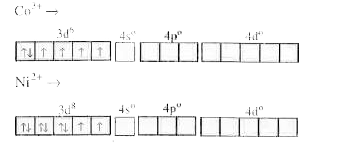Why [Co(NH3)6]3+ is an inner orbital complex where is [Ni(NH3)6]2+ is an outer orbital complex ?Solution in Telugu
In these complexes central metal ions are Co3+andNi2+

NH3 is a strong field ligand. It can cause pairing of unpaired electrons. In [Co(NH3)6]3+, if electron spins of Co3+ undergoes d2sp3 hybridisation by using two empty 3d orbitals. The complex is inner orbital complex.
In [Ni(NH3)6]2+, if electron spins of Ni2+ are paired up only one empty 3d orbital will be created. Thus Ni2+ undergoes sp3d2 hybridization by using two empty 4d-orbitals.The complex is an outer orbital complex.
Topper's Solved these Questions
- BOOK - AAKASH SERIESCHAPTER - COMPLEX COMPOUNDS EXERCISE - SUBJECTIVE EXERCISE -1 (SHORT ANSWER QUESTIONS)5videos
COMPLEX COMPOUNDS
- BOOK - AAKASH SERIESCHAPTER - COMPLEX COMPOUNDS EXERCISE - SUBJECTIVE EXERCISE -2 (SHORT ANSWER QUESTIONS)10videos
COMPLEX COMPOUNDS
- BOOK - AAKASH SERIESCHAPTER - COMPLEX COMPOUNDS EXERCISE - Objective Exercise-430videos
COMPLEX COMPOUNDS
- BOOK - AAKASH SERIESCHAPTER - CO-ORDINATION COMPOUNDSEXERCISE - PRACTICE SHEET - 5 ( Linked Comprehension type questions Passage : I I:)3videos
CO-ORDINATION COMPOUNDS
- BOOK - AAKASH SERIESCHAPTER - D & F BLOCK ELEMENTSEXERCISE - PRACTICE SHEET-5 (INTEGER ANSWER TYPE QUESTIONS)6videos
D & F BLOCK ELEMENTS
Similar Questions
What are double salts ? Write examples.
04:59View SolutionWrite the structures of following compounds:
(i) Tetraamminecopper(II) sulphate, (ii) Trichlorotriammine cobalt(III) , (iii) Tetracarbonylnickel(0) ,(iv)Dichlorodiammineplatinum(II) and (v) Trinitrotriamminecobalt(III)06:53View Solution(A) : Structure of [Co(NH3)6]+3 ion is octahedral
(R) : The coordination number of the metal ion is 606:53View SolutionThe CN of Ni+2=4
NiCl2+KCNexcess→A (cyano complex)
NiCl2+conc.KCl(excess)→B (Chloro complex)
The IUPAC name of A and B are06:00View SolutionHow many incomplete orbitals are present in inner transition elements ?
View SolutionExplain [Co(NH_3)_6]^(3+) is an inner orbital complex whereas [Ni(NH_3)_6]^(2+) is an outer orbital complex.
03:39View SolutionThe complex [Ni(NH3)6]2+ involves hybridisation of
02:45View SolutionThe complex [Ni(NH_3)_6]^(2+) involves hybridisation of
09:45View Solution[Co(NH_3)_6]^(3+) একটি অভ্যন্তরীণ কক্ষকঘটিত (inner orbital) কমপ্লেক্স কিন্তু [Ni(NH_3)_6]^(2+) একটি বহিস্থ কক্ষকঘটিত (outer orbital) কমপ্লেক্স। ব্যাখ্যা করো।
08:13View SolutionExplain [Co(NH_3)_6 ]^(3+) is an inner orbital complex whereas [Ni(NH_3)_6]^(2+) is an outer orbital complex.
04:28View SolutionExplain [Co(NH3)6]3+ is an inner orbital complex whereas [Ni(NH3)6]2+ is an outer orbital complex.
05:18View SolutionWhy [Co(NH3)6]3+ is an inner orbital complex where is [Ni(NH3)6]2+ is an outer orbital complex ?
04:55View SolutionExplain [Co(NH3)6]3+ is an inner orbital complex whereas [Ni(NH3)6]2+ is an outer orbital complex.
12:06View SolutionExplain [Co(NH_3)_6]^(3+) is an inner orbital complex whereas [Ni(NH_3)_6]^(2+) is an outer orbital complex.
View SolutionDiscuss the struchure of [Co(NH3)6]3+ ion on the basis of valence bond theory. Whether it is an inner orbital or outer orbital complex ion ?
View Solution[Co(NH_3)_6]^3+ is an inner orbital complex whereas [Ni(NH_3)_6]^(2+) is an outer orbital complex.Explain.
12:06View Solution

